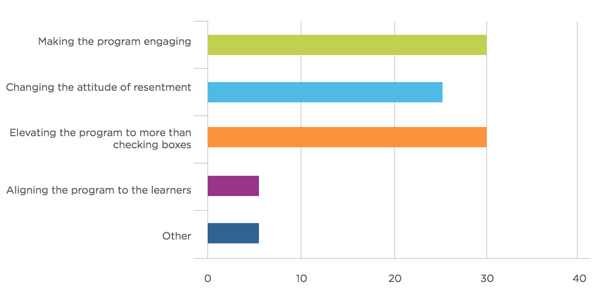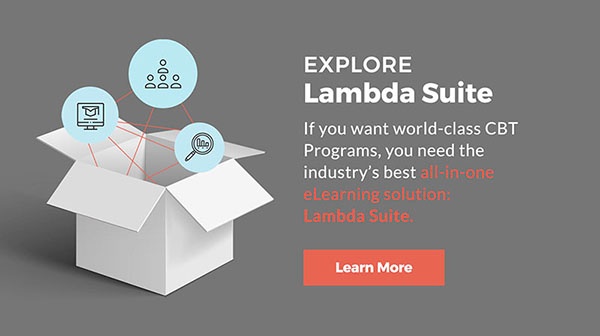Compliance training is often a legal and operational necessity, so why not make it as beneficial as possible? Build compliance into a competency-based framework to align learner and business goals, and send engagement soaring!
Keep reading or jump ahead to:
- Compliance Training Definition
- Compliance Training Challenges
- Competency Training Definition
- Competency Assessment: Observation checklist
For most skill-based activities, no matter if they’re big or small, there’s a difference between learner compliance and competency.
Passing your driving test makes you compliant with traffic laws, but it can take years behind the wheel before you feel like a truly competent driver.
.jpg?width=600&name=neonbrand-HN0FShqomik-unsplash%20(1).jpg)
Even after a lifetime spent enjoying a sport or hobby, there’s always something else to learn or improve upon.
The same goes for tasks in workplace environments: employees who pass compliance training remain on a learner pathway towards competency in their role.
This link between compliance and competencies reveals the key to valuable, engaging training.
Even though it may have been introduced due to legal requirements or a technical need, a compliance program should always recognize a learner’s desire to increase their competency. In other words, your compliance training needs to do more than satisfy an inspector or drill learners on the basic rules and regulations.
Let’s look into the differences between compliance and competency approaches, as well as how L&D teams can increase the role of competencies in training programs. After that, we’ll suggest a basic Observation Checklist, which combines the two training aims in one process.
If you’re searching for a deeper dive into the important links between compliance and competency, look no further. Here’s our full white paper on Compliance And Competency Training Made Easy With LMS.
Compliance Training
Compliance DefinitionWe can define a compliance program as any workplace training with the primary goal of educating and/or certifying employees on laws, regulations, and policies that apply to their job description and responsibilities. |
Why engage in compliance training?
Let’s face it—the only reason most teams and departments engage in compliance training is that they’re required to, either due to intra-company policies, or external rules. The intended benefit of compliance being that (at least theoretically) employees and customers enjoy a safe workplace, where tasks are carried out to agreed minimum standards.
The flip side of creating enforceable minimum standards is that teams and entire companies can fall foul of regulations.

According to an ADP Research Institute survey, 30 percent of mid-sized companies have incurred costs due to non-compliance, from penalties and fines all the way up to lawsuits.
An effective compliance training program, therefore, treads a fine line between establishing real and effective standards, and not making compliance so difficult to achieve that teams fail to gain the necessary credentials.
What should compliance training look like?
Before we get into the benefits of combining compliance with competency-based training, let’s define an ideal compliance program.
Here, we’re interested in training that actively goes above and beyond basic certifications to add real value to daily workflows. Such a compliance program arguably meets seven criteria:
- Clear rationale. Training is positioned towards a clear and transparent objective. Learners know what they’re aiming to achieve, and why.
- Effective instruction. Content effectively presents policies, procedures, skills, and all necessary information. Resources are authoritative, accessible, and engaging.
- Receptive. While compliance training may be mandatory, it makes space for employee input, which increases engagement and satisfaction.
- Applicable. Training directly addresses employee tasks most relevant to compliance needs.
- Safety. Training allows for ample opportunity to safely practice steps and skills. Training promotes a safe space for failure en route to skill acquisition i.e. via simulation training.
- Support. Learners feel able to raise questions and request support in gaining compliance.
- Rewards. Compliance is not viewed simply as given but an achievement worthy of recognition by the wider team. Compliance training is integrated into wider training and performance management.
Challenges for compliance programs
While I’m not familiar with how compliance training looks inside your particular organization, I’m willing to bet that it rarely, if ever, meets all seven of the above criteria. (If it does, then well done! Any chance you’re already integrating competencies?)

The reason that most compliance programs fail to meet the mark is usually two fold:
- First, training is viewed as compulsory, arduous, and relegated to the bottom of the priority list.
- Second, expanding compliance requirements across many industries means that time is spent interpreting regulations and turning them into business practices, rather than ensuring an optimal training experience.
Both of these constraints result in a limited, negative training environment. In other words, compliance becomes viewed as something to be dealt with as quickly and as cheaply as possible. This puts learners—who are likely already stretched for time—on the defensive, making them quick to dismiss potential learning opportunities.
Making matters worse is the fact that many compliance courses include unavoidable assessment and certification elements, which can be stress triggers, especially for learners with negative associations to schooling and the education system.

Lambda Solutions surveyed customers on key compliance frustrations. Read more about the survey in our whitepaper: Compliance and Competency Training Made Easy with LMS.
When compliance training is operating on this level, it risks becoming disconnected from a wider L&D effort. Even if it’s housed within official workplace training, compliance programs aren’t going to be providing you with the same level of learner data and analytics potential as more engaging elements of your training offering.
As a result, it becomes hard to assess real performance (not just pass/fail rates), and compliance won’t contribute to improvements for your learners’ goals or your wider business objectives.
Why compliance training is not enough: shortcomings in current compliance-centric training programs
 Even if a compliance program does hit each of those seven ideal criteria, it still may not be enough to meet the needs of a modern day workforce.
Even if a compliance program does hit each of those seven ideal criteria, it still may not be enough to meet the needs of a modern day workforce.
Beyond a lack of engagement and negative connotations, the narrow focus of compliance training means it just can’t adequately address situations where a significant change in skill set is necessary...
—which wouldn’t be an issue, if our jobs were static entities!
But as anyone who’s navigated an office environment over the last decade or so will tell you, static roles are a thing of the past. Today’s employees may take on several different areas of responsibility over their career, and experience any number of technology or industry-driven disruptions.
Compliance training is not built for this level of fluidity and flexibility. While a compliance program may be perfect for teaching and measuring one specific workflow, it’s incredibly difficult to use compliance to measure an employee’s wider technical or personal ability. At an organizational level, this creates uncertainty over the skills on offer within a team, raising the potential for costly skill gaps.
As a result, planning future training becomes far more difficult and expenses tied to last-minute fixes when these ‘blind spots’ are discovered will quickly escalate.
How to beat these challenges?
The theory is simple: if you make a connection between compliance and the competencies that
(a) learners actually want to develop
(b) will genuinely benefit your business
then compliance training becomes a more worthwhile and integrated part of L&D.
So what are competencies, and how do we make a competency checklist part of compliance training? Here’s our take:

Competency training
Competency definitionWe can define a competency program as any workplace training that aims to develop sets of interrelated knowledge, skills, attitudes, and experiences that contribute to an employee’s ability to perform in their role. Competencies are normally defined by their application. For example:
Give yourself a foundational understanding of competencies by reading our article on 3 Core Competencies Your HR Must Have For Successful L&D. |
Why use competencies?
Competency-based training is a natural engagement booster, because it’s learner-first by design. Positioning training towards sets of competencies rather than an artificial rubric or externally-imposed certification keeps content relevant and implementable.
A well-functioning competency-based program will:
- Align roles and responsibilities with their requisite skills for optimal job performance
- Provide instruction on specific role-related skills
- Focus on behaviors and approaches
- Standardize and eliminate redundancy in training requirements
- Standardize the accreditation of educational programs
- Provide a better definition of career tracks
- Help identify skills gaps and training needs to get optimal results
- Clearly define performance evaluations on a scale: not competent, competent with supervision, competent
The ideal competency-based program will identify each role in the operational process, define all the skills and competency levels for each role, and identify all the associated compliance requirements.
This management approach automatically links compliance, skills training with learner performance. In this way, competency-based compliance training helps organizations better understand the training needs of their employees, and respond to any issues with support that’s informed and sensitive to the full learner profile.
Over time, broadening the focus from strict compliance to personal competencies reduces the risk of non-compliance, by monitoring and maintaining overall training success. It’s a key insight used by many of the most successful startups: when all aspects of learning contribute to personal development, both the learner and the business wins.
Watch our webinar on Why You Should Be Running Your L&D Team Like A Startup for more on making training personal (and effective)!
Competency Framework
Think of competencies as the knowledge and skills that make compliance work on the ground. While accrediting bodies may need proof of specific certifications and compliance credentials, a competency framework will help learners develop the ability to maintain compliance on a daily basis as a functioning part of their role.
Today, it’s easier than ever to combine these two essential training aspects under one roof, thanks to the latest eLearning platforms.
Integrated solutions such as Lambda Suite combine training and instruction with data-led learner management, allowing L&D staff to support learners while also producing necessary compliance reports.
A competency framework is the basic structure that allows you to set up a productive system for training: It should determine learning pathways, lead to analysis of training gaps, and house compliance needs. Here’s what a general seven-step competency framework might look like:
- Definitions. Begin with identifying each role within the operational process, define the skills and competency levels for each role (e.g., Basic, Intermediate, Advanced, Expert), and finally define the purpose of training and training programs that align to each skill and level. What are business, compliance, and learner needs?
- Observations. Measure and evaluate day-to-day workflows. Look for gaps between projected and actual attainment. These might be skill or compliance gaps.
- Opinions. Bring in stakeholders to discuss Step 2 findings. Do results square with personal opinions, and how do learners define and rate training needs?
- Goals. Finalize role-related goals. These should draw from stakeholder discussions on expectations, incorporate legal compliance requirements, and connect to organizational KPIs.
- Hierarchies. Groups goals to create learner pathways and associated competencies.
- Training. Track and report qualification to these programs. Implement learner pathways. Support learners by focusing on the skills and attributes needed to progress towards each competency.
- Evaluation. Assess each individual and rate them against the defined skill and level for their role. Identify skill gaps and drive training that closes these gaps and drives an individual to a new level. Monitor skill development and track progress.
Competency Assessment: Observation checklist
Competency assessment is defined as any system for measuring and documenting individual competency. Its goal is to identify gaps in skills that impact employee performance and to address these with appropriate task-specific training intervention.
A competency assessment method used in many organizations is known as an observation checklist. Sometimes it is also referred to as a performance checklist.
An observation checklist enables organizations to conduct focused measurement and evaluation of the performance and behavior of individuals within an on-the-job setting.
Observation checklists assist an observer in assessing a learner’s competency in a task, identify skill gaps and problem areas to further improve training design, strategies and learner development.
Typically, observation checklists consist of simple yes and no questions for documenting the performance of required skills. However, to better qualify a learner’s competence or mastery in a skill, a proficiency scale (e.g., Awareness, Basic Application, Skillful Application, Mastery) is better suited for measuring the level of skill over simple yes or no responses.
Use of observation checklists provide companies with:
- Accurate and timely regulatory reporting.
- Defined observation ratings and methods.
- Insight into compliance and skills gaps to identify areas for additional training and support.
- Run reports on-demand for access to completion data, upcoming deadlines, or specific competency achievement by roles or units.
Here’s how a simple, competency-based compliance observation checklist might look.
Instead of evaluating training by degrees of compliance (or even just a simple checkbox pass/fail), this type of checklist determines compliance by a performance rubric. This gives learners and educators more insight into progress, and helps illustrate true competency levels.
In other words, a competency-based checklist like this is a more granular way to judge performance.
This doesn’t negate the fact that task observation is often a valuable learning tool, nor that it may be a required part of compliance. Objective compliance standards are still set and recorded, and can be reported just as easily.
|
Observation (or performance) checklist |
||
|
Task(s) Tasks are broken down and described in detailed steps. |
Performance objective(s) Performance on each step is evaluated via a competency-based criteria. Performance levels: 4. - Meets full competency 3. - ↓ 2. - ↓ 1. - No demonstration of competency |
|
|
Step 1 |
Level: |
Pass? |
|
Step 2 |
Level: |
Pass? |
|
Step 3 |
Level: |
Pass? |
|
Step 4 |
Level: |
Pass? |
|
Pass threshold: (e.g 75% = pass) |
Final result: |
|
Here, compliance for each step might mean achieving a minimum performance level three, while compliance for the overall task itself might require passing at least three steps.
Alternatively, if the checklist was used to judge compliance for legal or safety requirements, then employees might need to reach full competency for each step to record a pass.
While a competency-based checklist obviously doesn’t have to look anything like this, the theory holds true: shifting evaluation methods towards competencies gives everyone a better insight into real learner performance, which supports better training, and through it, improved compliance.
Summary
Let’s go over a quick recap on the advantages of shifting perspective from compliance to competencies:
- Delivering compliance training through competencies let’s L&D see the full picture of learning. When all training is orientated towards a single goal (developing learner competency), it’s easier to give those struggling with compliance real and useful support.
- By the same measure, focusing on competencies means each role receives a more complete training offering. Progress towards compliance is granular, easing onboarding and making for better succession planning (on that topic, here’s 7 Easy Steps for Business Succession Planning Success).
- Competency frameworks create better tools for learner evaluation. Not only will L&D be collecting data on basic compliance, but also on learner engagement and performance—simple to collect and evaluate through Lambda Analytics and Totara.
For more advice, best-practices, and how-to guides to creating, implementing, and improving your Learning and Development programs, we have all of these additional resources:
- eBook: Big Data for HR: How Predictive Analytics Can Deliver Business Value
- eBook: Compliance and Competency Training Made Easy with LMS
- Case Study: Reduce Admin Time and Provide More Effective and In-demand Resources to HR Professionals
- Article: 3 Core Competencies Your HR Must Have For Successful L&
- Article: 7 Easy Steps for Business Succession Planning Success
- Webinar: Why You Should Be Running Your L&D Team Like A Startup
- Webinar: Faster, Better, Easier User Management With Totara HR Import
- Webinar: How to Make Compliance Simple Yet Effective
- Webinar: Ability and Appliance - Using Competency and Compliance for Moodle
- Webinar: Ability and Appliance - Using Competency and Compliance for Totara





